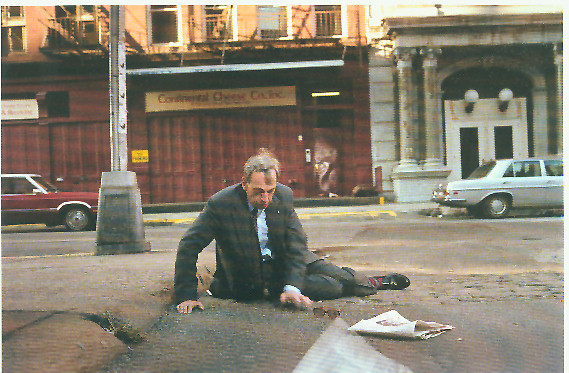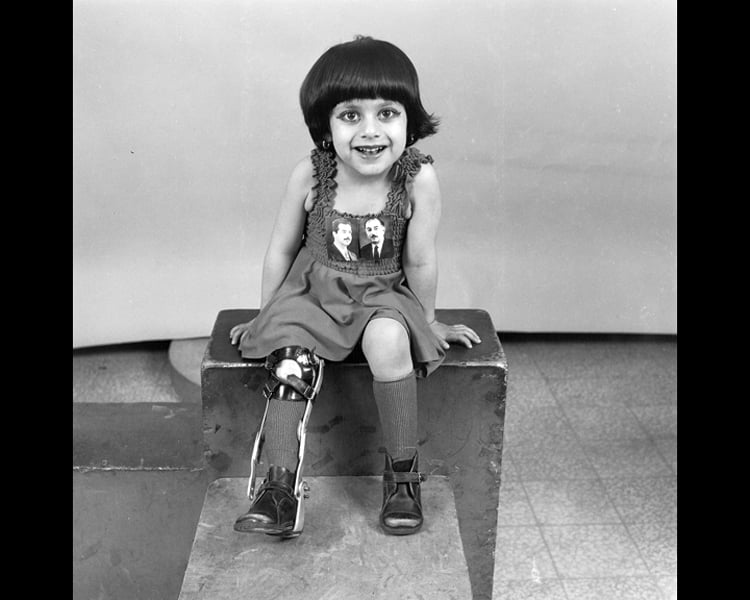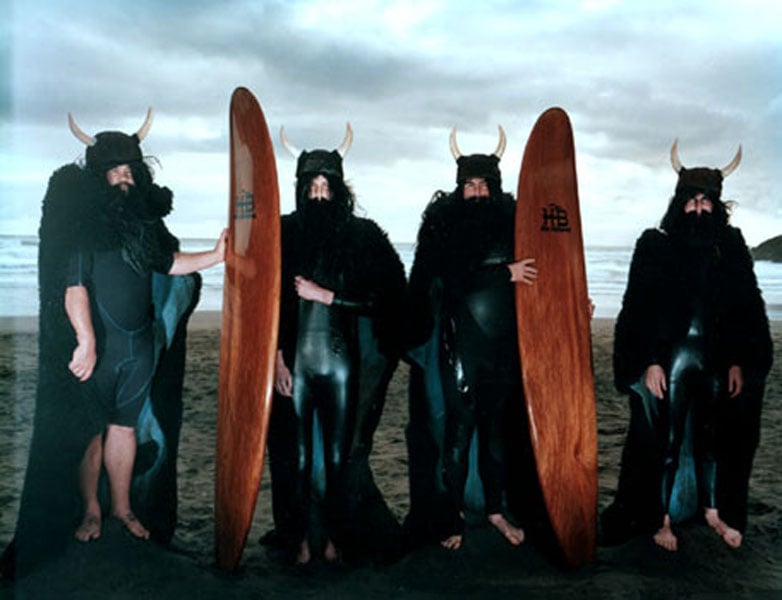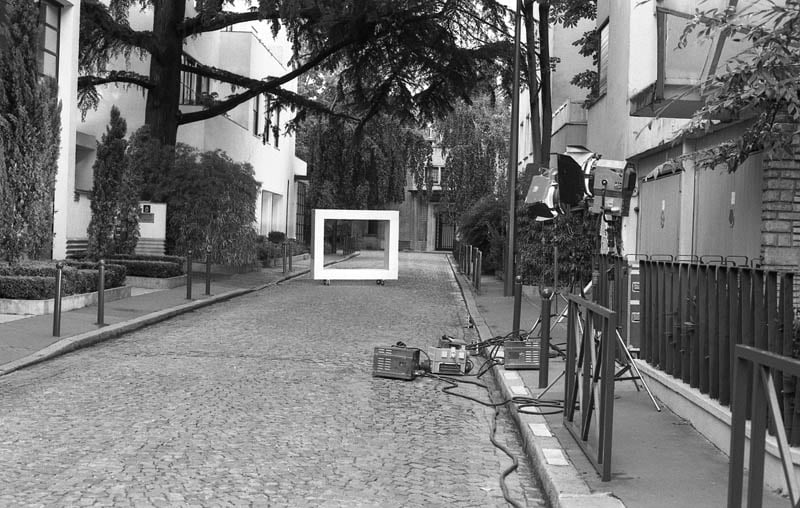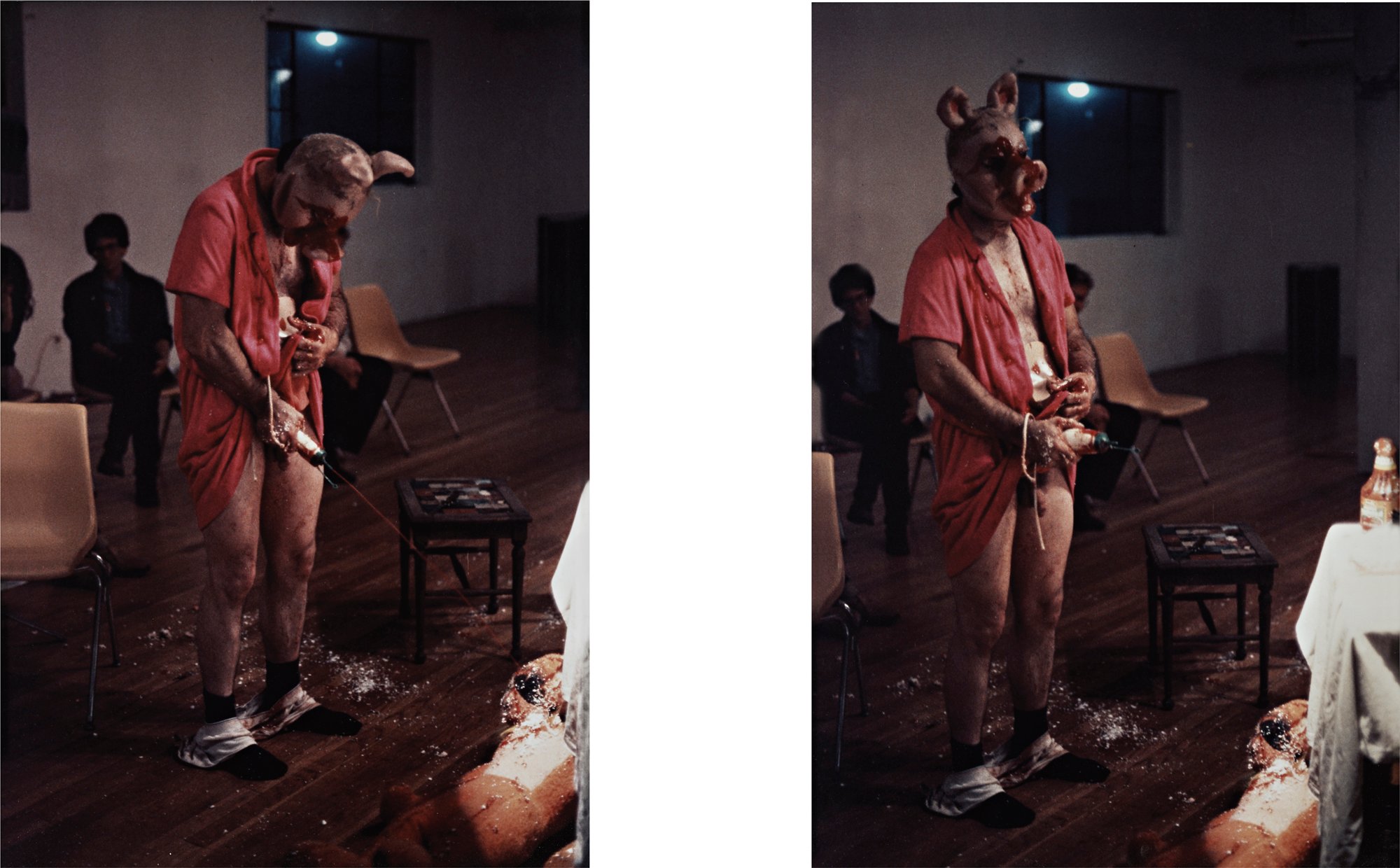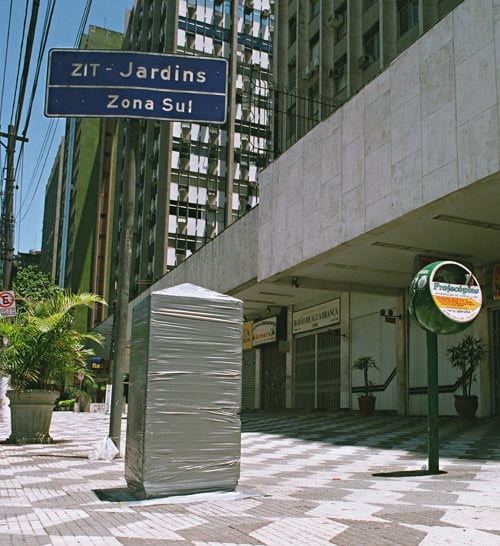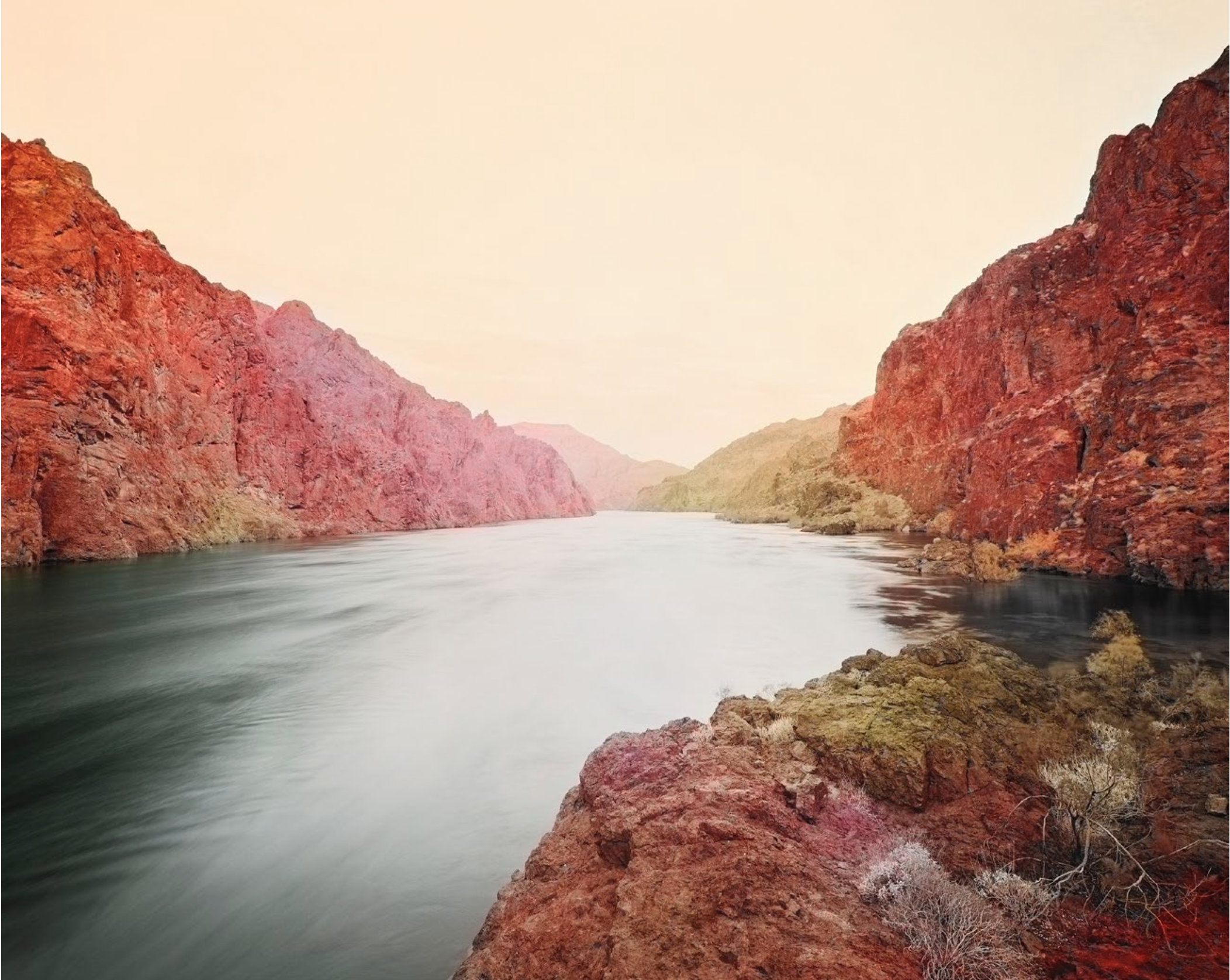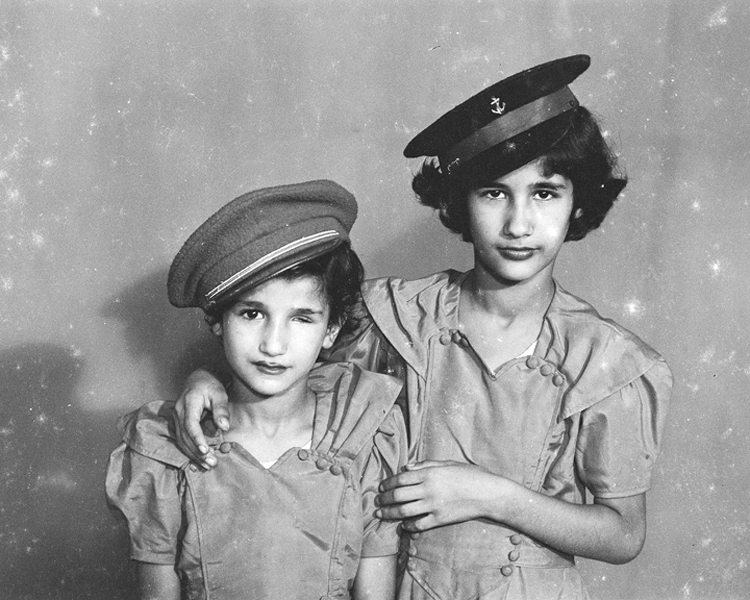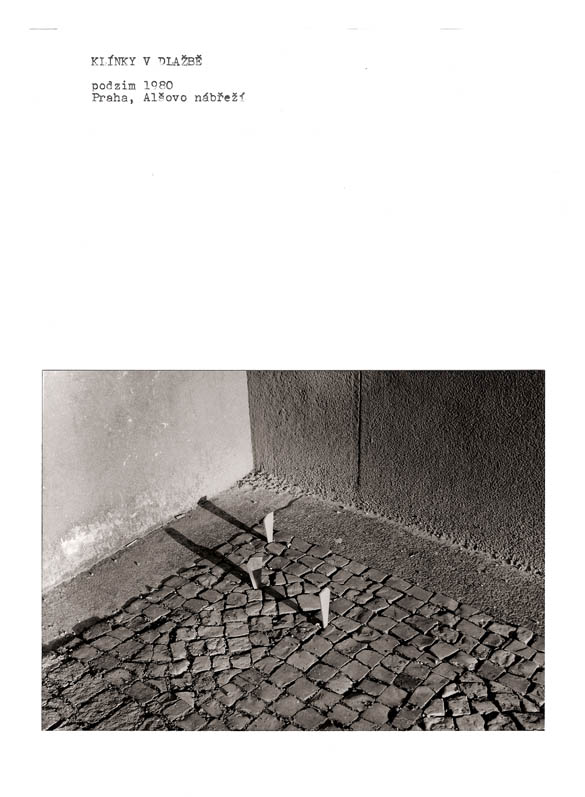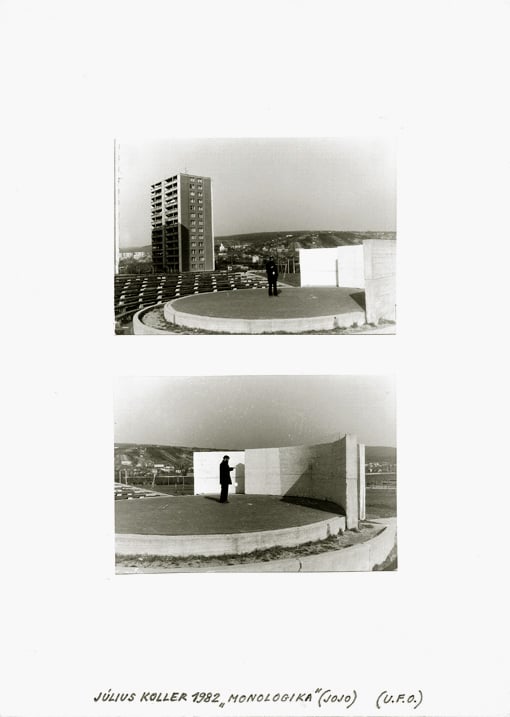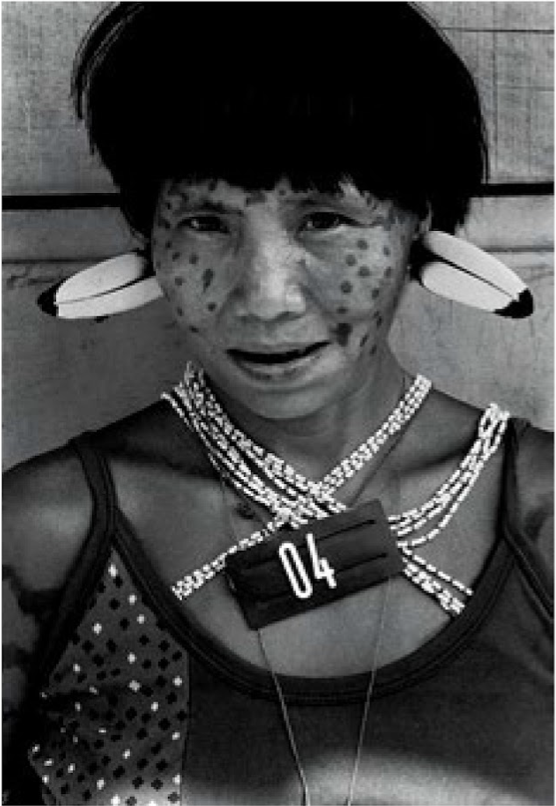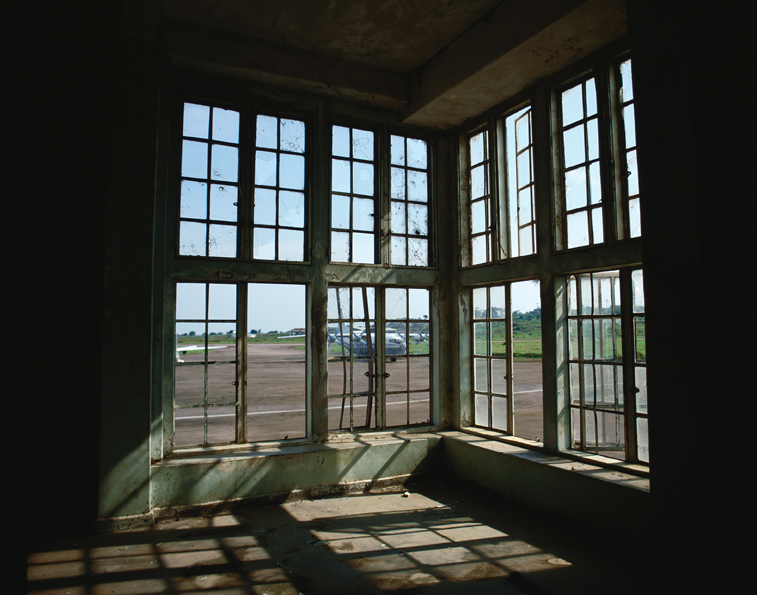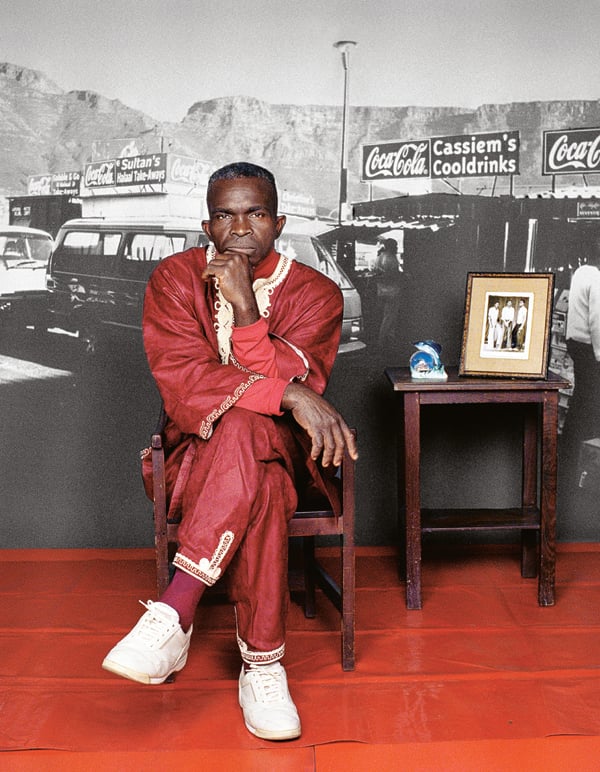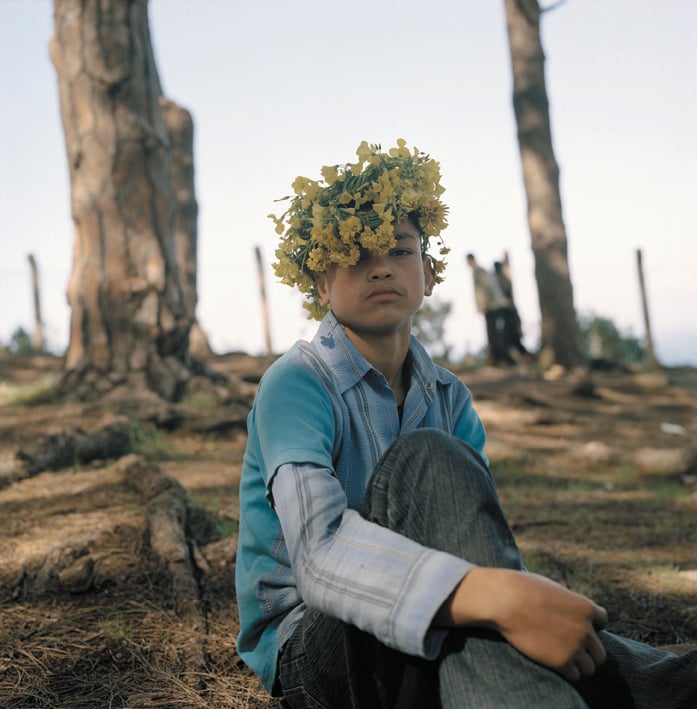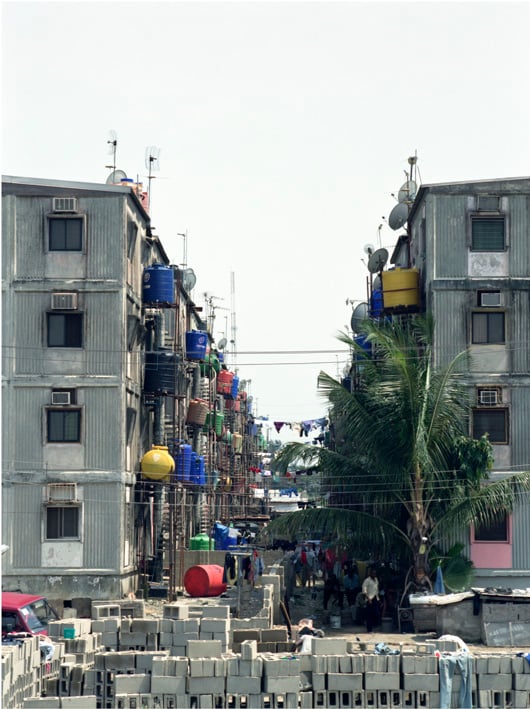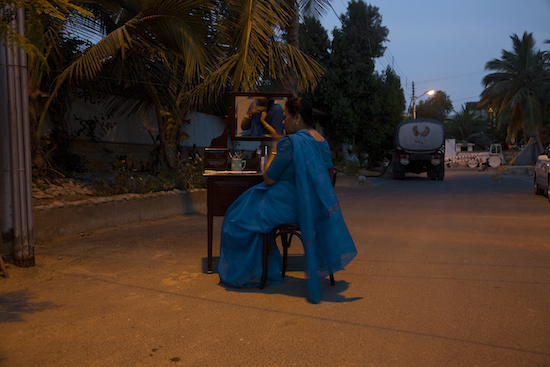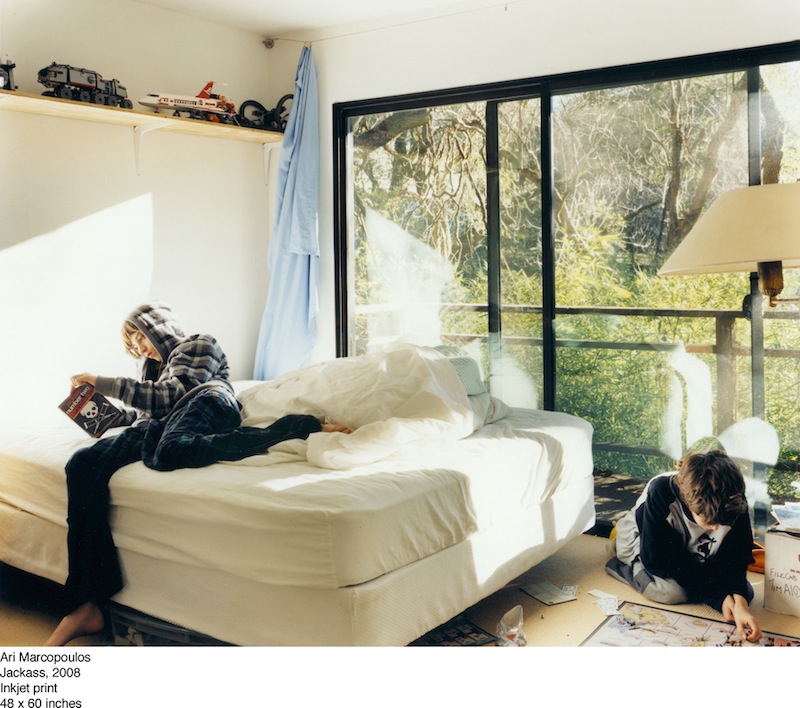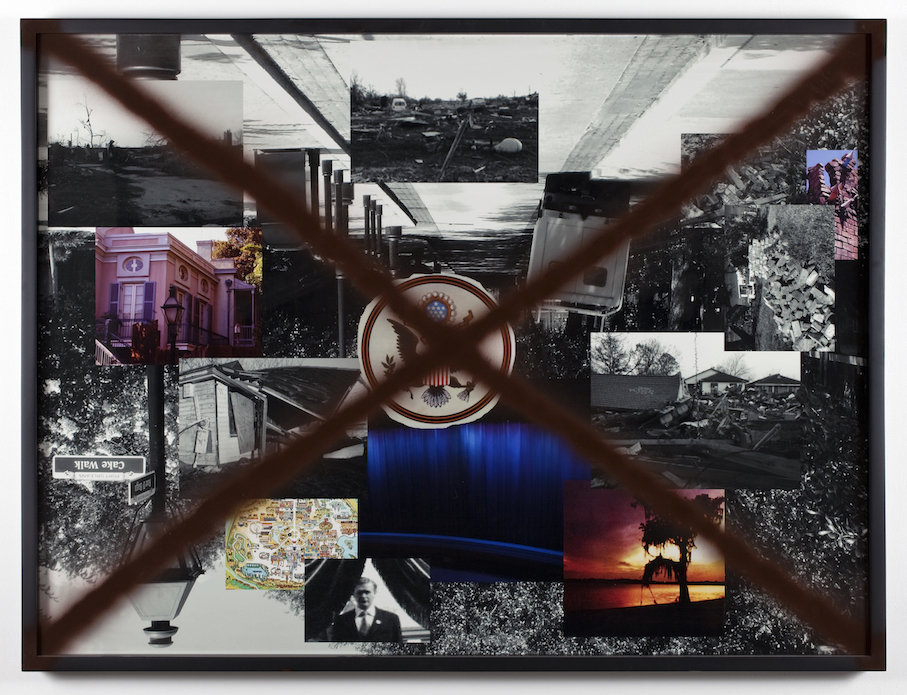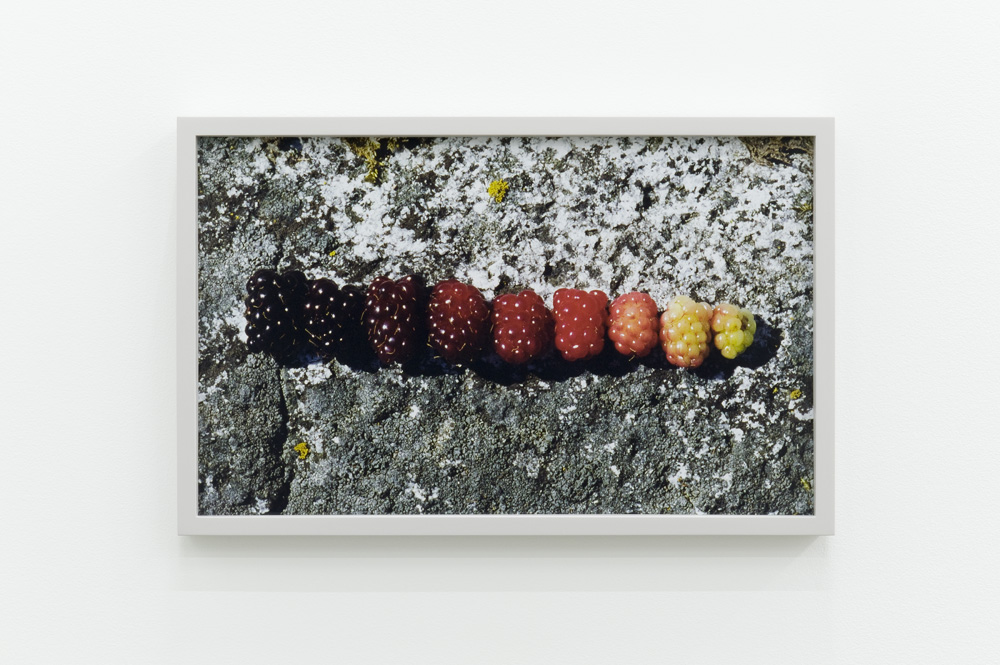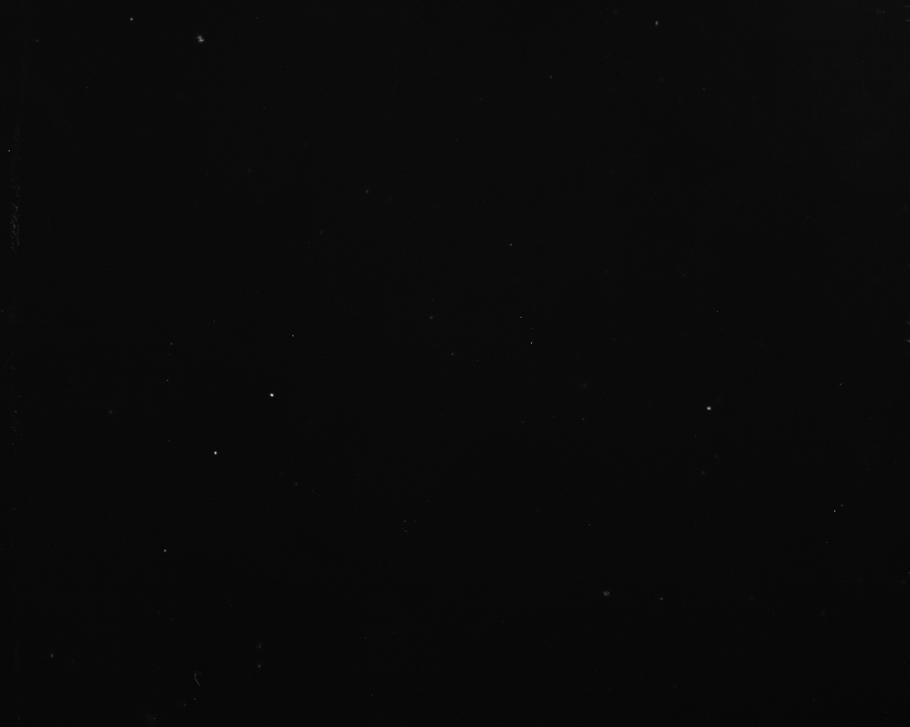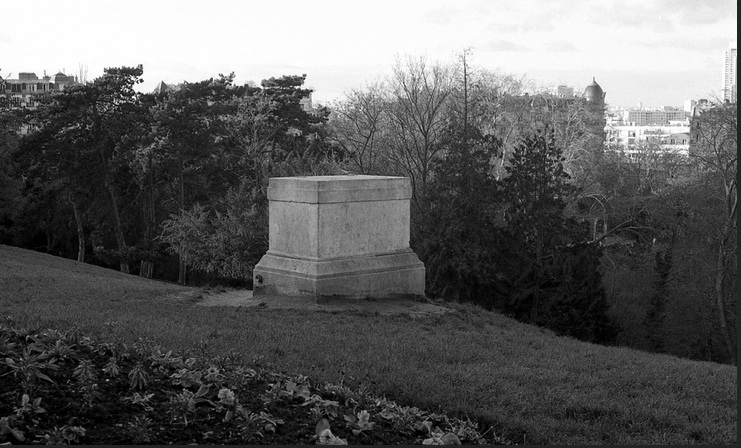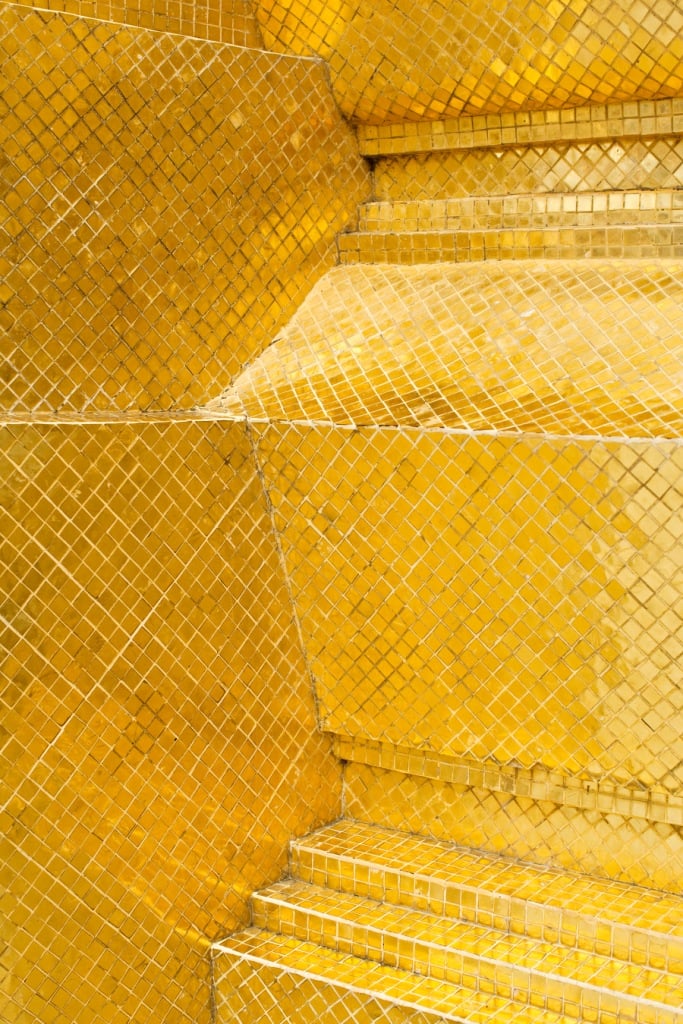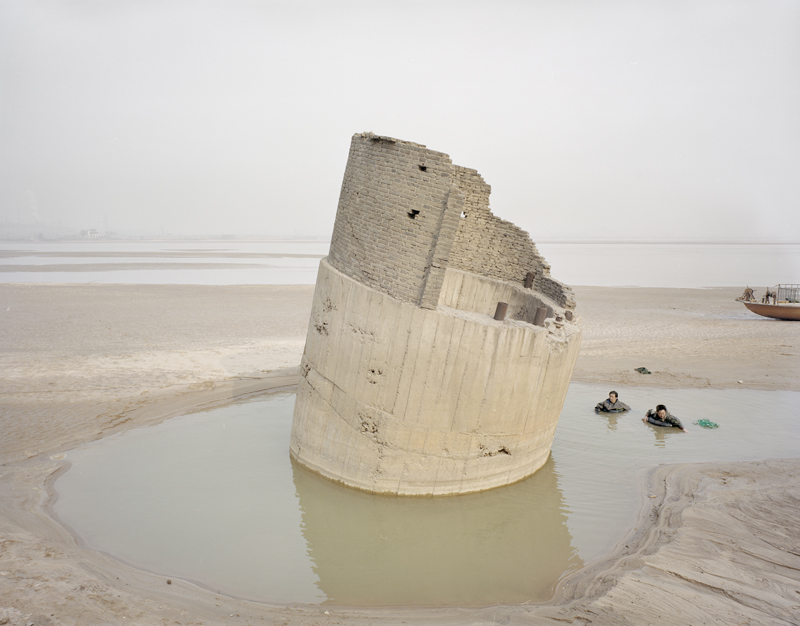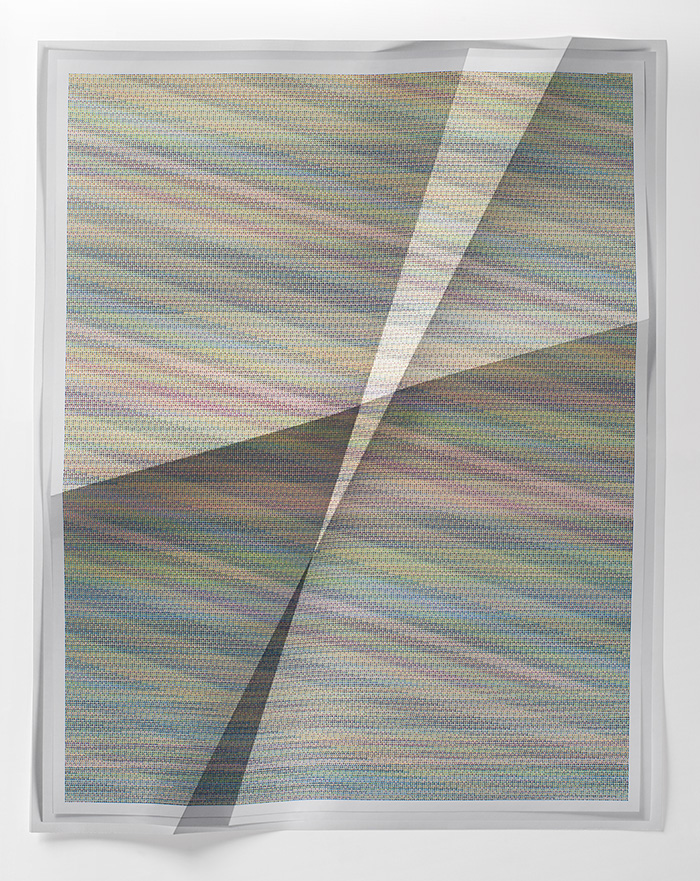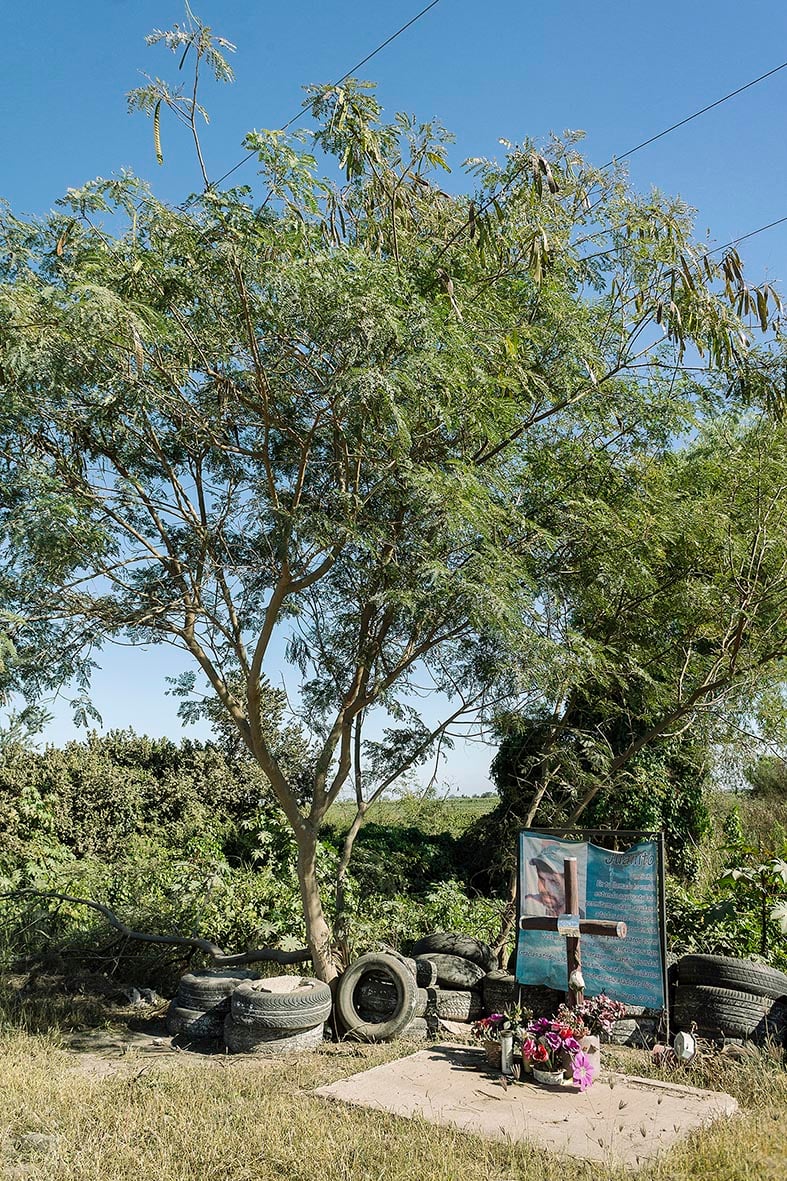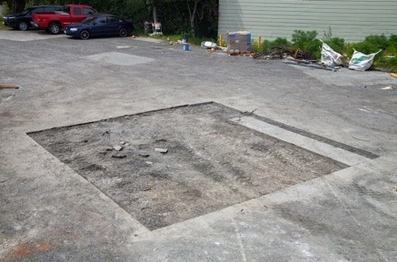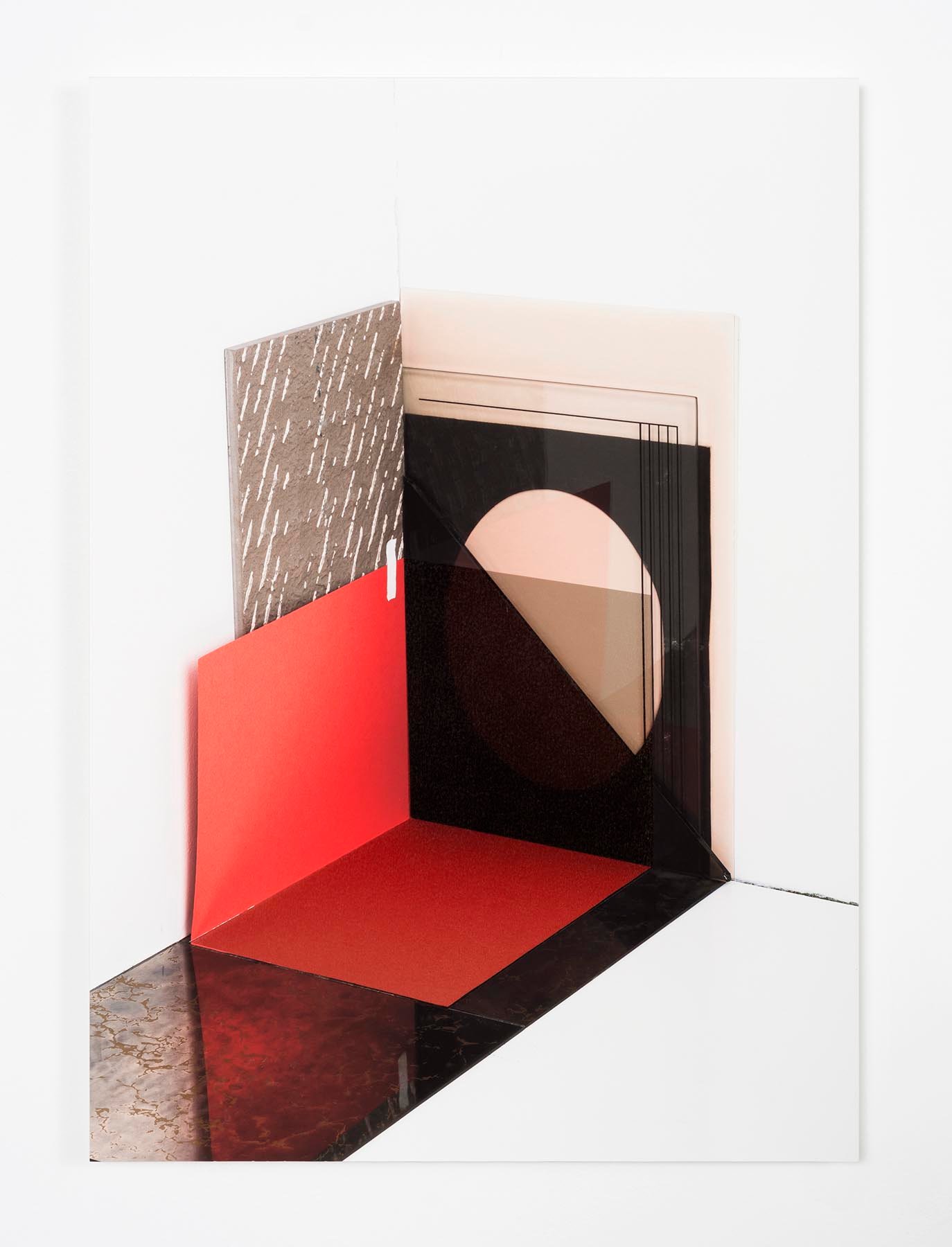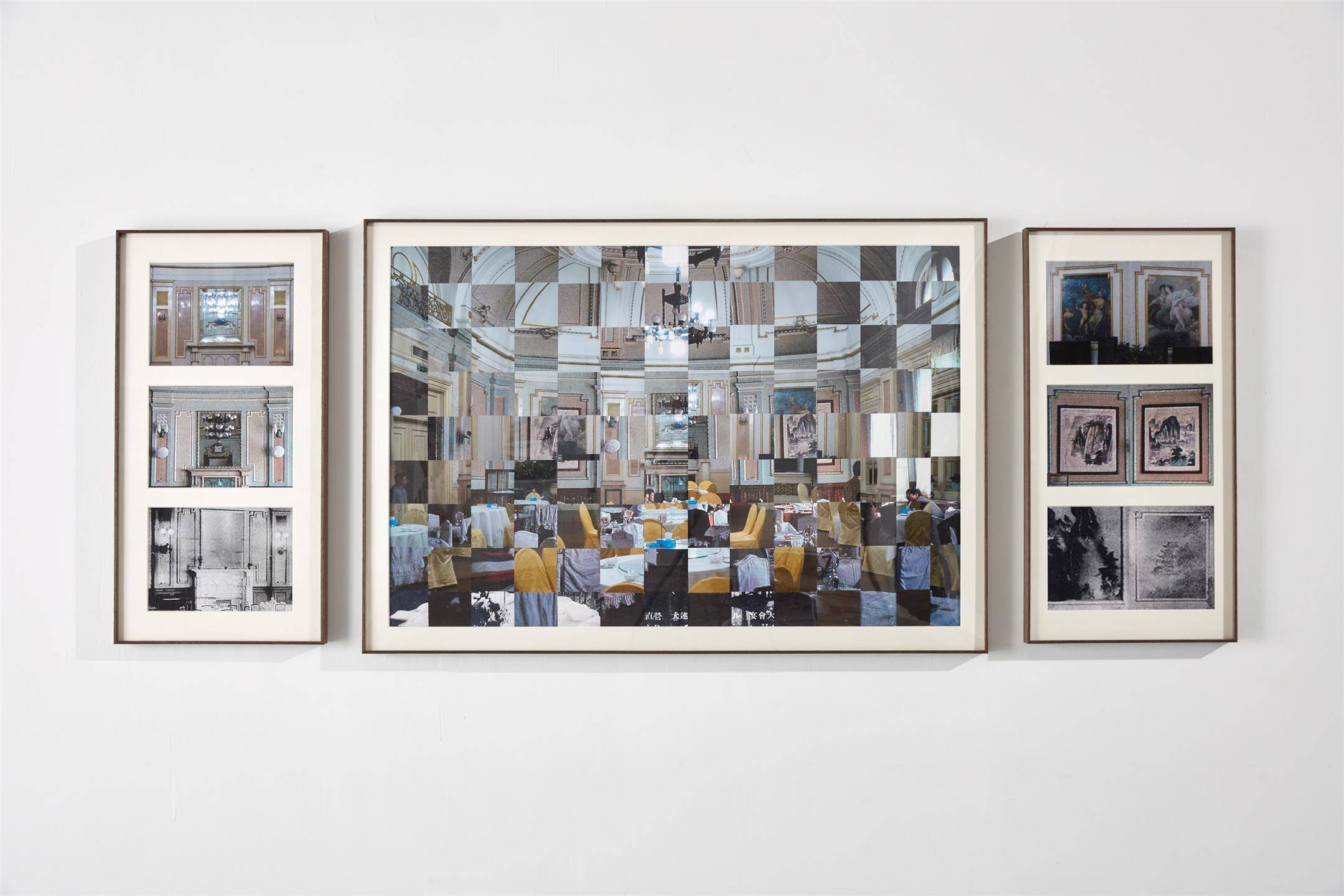
© » KADIST
Jiang Pengyi
Unregistered City is a series of eight photographs depicting different scenes of a vacant, apparently post-apocalyptic city: Some are covered by dust and others are submerged by water. Yet, ambiguous lights blink from buildings and yachts still sail on the water, and further observation reveals these structures to be miniatures manipulated by the artist through Photoshop and other postproduction image tools. The model city’s surroundings are themselves real abandoned spaces, perhaps an empty room, a wait-to-be demolished building, or a discarded bathtub.

© » KADIST
Collier Schorr
Collier Schorr’s prints upend conventions of portrait photography by challenging what it means to “document” a subject. American Flag (Scratch) (1999), for example, depicts an unidentified male subject clad in an American flag-print singlet. With his head and extremities out of frame, the camera focuses on his flush-red torso, his left nipple protruding from the singlet’s strap.

© » KADIST
Victor & Sergiy Kochetov
Having a press card allowed Viktor Kochetov to photograph freely in public places, access to which was strictly regulated for amateurs. Seeking a way to transgress the reportage canon, the Kochetovs employed a method of taking images of large gatherings that emphasize the structure and “patterns” of the imaginary collective body. His 1978 photo of women sorting corn, titled Working women, builders of communism, are sorting corn… , is organized on this principle: the scarfs on the workers’ heads are perceived as an element of uniform, which creates a visual rhythm.

© » KADIST
Luis Pazos
La Cultura de la Felicidad (The Culture of Happiness) is a series of five photographs addressing everyday life—a couple in a bed, lovers on a bench and a family reunion. The subjects wear masks made of white cardboard. The series suggests the idea of a reality hidden under the appearances of the power in place that denies violence to citizens.
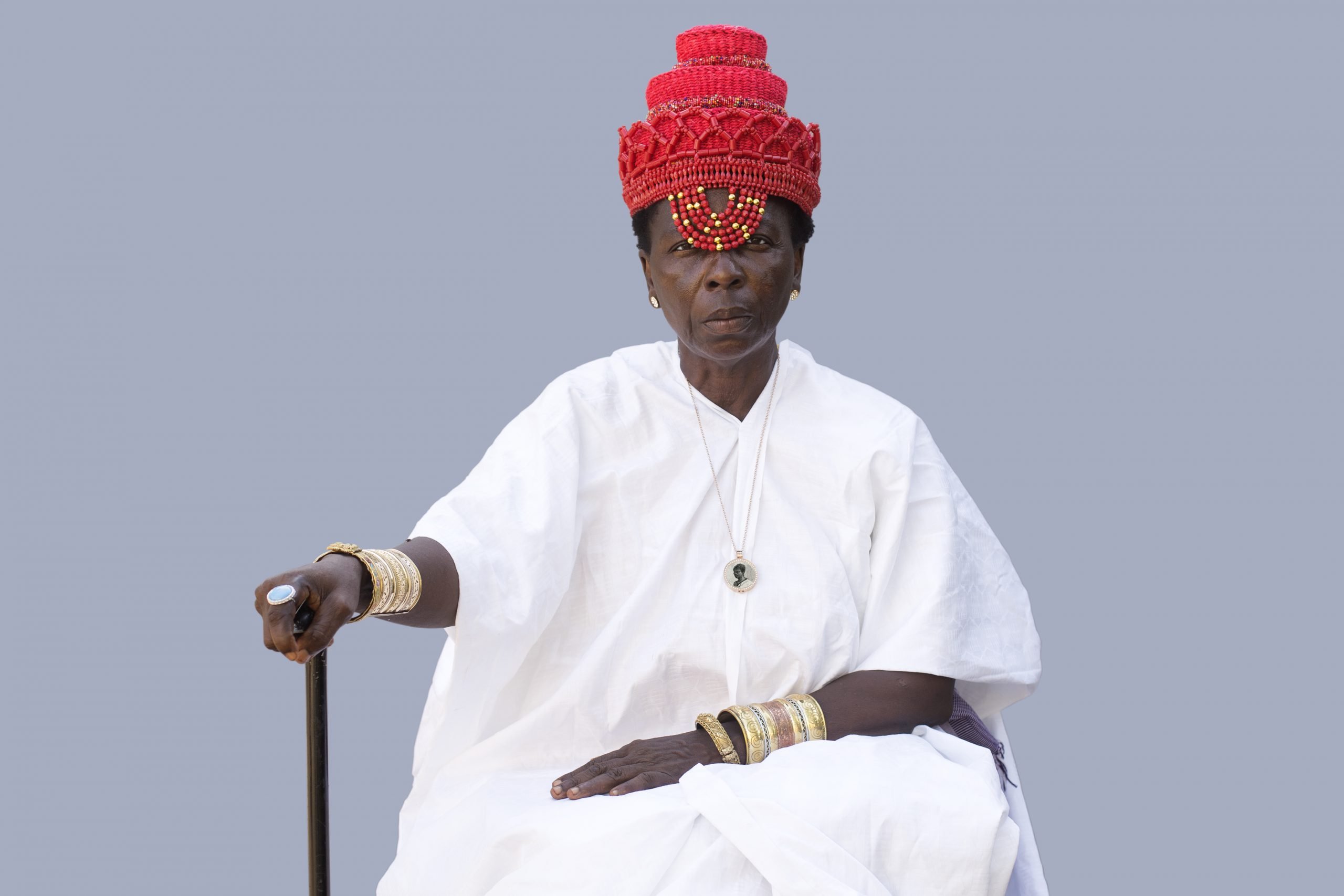
© » KADIST
Ishola Akpo
Noticing the lack of archives on the queens of various African kingdoms, artist Ishola Akpo created several series of work that retrace their history. Akpo uses different mediums in these projects, as a metaphor to the complex stories of the figures and their true political weight. One part of the project, the Agbara Women photographic series, employs fictional portraits that sheds light on the queens’ histories.

© » KADIST
Nguyen 'Quoc' Thành
A Soldiers’ Garden by Nhà Sàn Collective is a night portrait series located in an army camp outside Hanoi. Here new recruits assemble for basic training during the first months of their military service, before they are relocated to their assigned battalion. Night is the only time the soldiers in training have a few moments for themselves.

© » KADIST
Pratchaya Phinthong
In order to make If I dig a very deep hole (2007) the artist looked for the extreme geographical opposite of Paris when drawing a straight line throughout the globe. Then, he went to this place, the Chatham Islands in New Zealand, to photograph the full moon before coming back to Paris to take a picture of that same moon. This work brings together two diametrically opposite places, two singular experiences, two different moments and the same full moon.

© » KADIST
Xyza Cruz Bacani
Occupy HK 2014 is a series of 18 photographs that Xyza Cruz Bacani’s shot at the height of the Umbrella Movement in Hong Kong. At the time, the Umbrella Movement was considered the largest social unrest defending the democratic aspirations of Hong Kongers, who flooded the streets to demand universal suffrage. The protestors even managed to block Hong Kong’s main highway for months, freezing Asia’s financial centre.

© » KADIST
Eileen Quinlan
Eileen Quinlan’s abstracted images, like Swipe , rely on the manipulation of photographic materials inside the studio itself, and reject the exterior world for complex interrogations of the medium.

© » KADIST
Charwei Tsai
Charwai Tsai’s photograph documents her Hermit Crab Project installation upon the construction site of gallery Sora in Tokyo. Tsai placed live hermit crabs and shells in a sandy enclosure at the site, writing fragments of The One China policy and the Taiwanese Independence statements on each shell. As the hermit crabs moved and swapped shells, they formed new connections between the statements.

© » KADIST
Carolina Caycedo
YUMA o la tierra de los amigos (YUMA, or the Land of Friends) by Carolina Caycedo is a large mural containing a series of satellite photographs mounted on acrylic. The mural contrasts and mixes multiple layers of these satellite images capturing the progressive devastation of the El Quimbo dam on the Yuma river (Magdalena), in the Department of Huila. The project was originally produced for the 8th Berlin Biennale, and developed out of the artist’s research into waterways, their political and cultural impact, and their historical development.

© » KADIST
José Castrellón
Palo Enceba’o is a project by José Castrellón composed of three photographs, two drawings on metal, and a video work that creates a visual and cultural analogy between the events of January 9th, 1964 in Panama City and the game of palo encebado carried out in certain parts of Panama to celebrate the (US-backed) independence from Colombia. In the game, young men climb a wood post smeared with animal wax to collect a Panamanian flag in return for a bounty. During what is now remembered as Martyrs’ Day, Panamanian students trespassed the fence that separated the American-governed strip of land along the Panama Canal and Panama City to fly a flag and symbolically claim sovereignty over the area that had been turned over to the United States by the Hay–Bunau-Varilla Treaty in 1903.

© » KADIST
Trevor Paglen
Half Dome Hough Transform by Trevor Paglen merges traditional American landscape photography (sometimes referred as ‘frontier photography’ for sites located in the American West) with artificial intelligence and other technological advances such as computer vision. This photograph was taken at Half Dome, a frequently visited granite rock formation in Yosemite National Park, California. For this work, Paglen created a digital file of the 8 x 10 inch photographic negative so that the artificial intelligence program can apply computer vision to evaluate the content of the image.

© » KADIST
Joachim Koester
Physical and mental exploration have been founding elements in Joachim Koester’s research for several years. While exploration was mainly a matter of geography during the 19th century, the 20th century brought the mental exploration of our unconscious, triggered by the discovery of psychoanalysis. Koester is interested in documenting minor events, forgotten by History, in order to reintroduce them into collective memory.

© » KADIST
Paolo Cirio
Capture is a photographic series by Paolo Cirio in which the artist sourced 1000 public images of police officers’ faces and processed them with facial recognition technology. The original photographs were taken during protests in France, Cirio collected these images and created an online platform containing a database of the 4000 police faces that the AI program isolated. The artist crowdsourced their identification by name and then publicly exposed the officers by printing their headshots and posting them throughout Paris.

© » KADIST
Paolo Cirio
Capture is a photographic series by Paolo Cirio in which the artist sourced 1000 public images of police officers’ faces and processed them with facial recognition technology. The original photographs were taken during protests in France, Cirio collected these images and created an online platform containing a database of the 4000 police faces that the AI program isolated. The artist crowdsourced their identification by name and then publicly exposed the officers by printing their headshots and posting them throughout Paris.
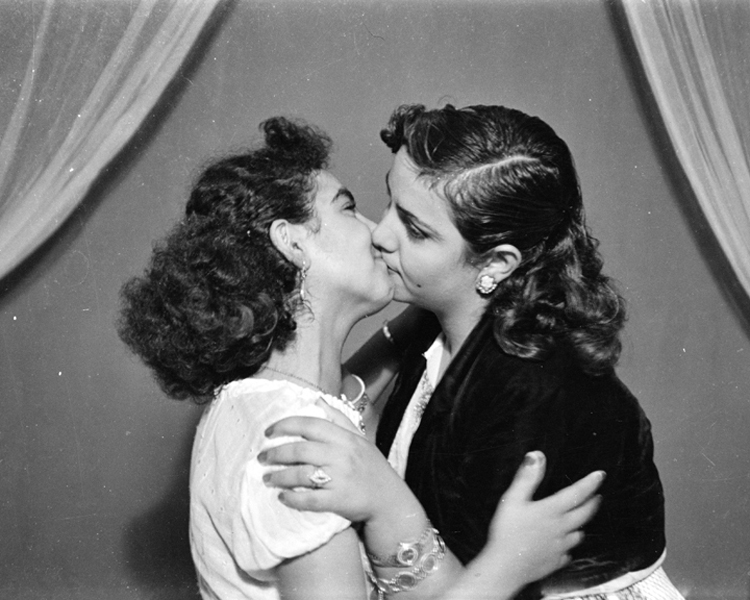
© » KADIST
Akram Zaatari
“Films inspired people a lot. they came to perform kissing in front of a camera. In a conservative society such as Saida, people were willing to play the kiss between two people of the same sex, but very rarely between a man and a woman.

© » KADIST
Ilana Bar
One of Ilana Bar’s best-known works is the series Transparências de lar (Home Transparencies) in which, for four years, the artist photographed her family’s rural home in Atibaia where her father lives with his two brothers and Ilana’s own brother, all three with Down Syndrome. Transparências de lar is the record of a serene, though certainly not a perfect, place. In this place Down Syndrome is not considered an alienable difference in the way that it is in Western culture, it is not problematic or a cause for social exclusion.

© » KADIST
Julian Abraham
In 2015, while in residence at the Jatiwangi Art Factory (JaF) located in the village of Jatisura in Jatiwangi, West Java, Indonesia, Togar initiated the Jatiwangi Cup in which the artist, together with communities in the area, established an annual bodybuilding contest. The area is renowned for its roof tile factories, and the cup aims to celebrate the factory worker’s physiques, sculpted by intense, daily, physical labor. Togar based the idea of the cup on the simple notion of collectivity.

© » KADIST
Naoya Hatakeyama
Naoya Hatakeyama’s series Rikuzentakata (2011) documents the devastating aftermath of the 2011 Tohoku earthquake and tsunami in Japan. Throughout the series of sixty C-prints (five of which are included in the Kadist Art Foundation’s collection), Hatakeyama’s photographs depict scenes of torn landscapes and leveled homes, demolished villages and massive piles of detritus pummeled beyond recognition. The images serve as records of disaster, seemingly driven by an intense need to bear witness to collective trauma.

© » KADIST
Uche Okpa-Iroha
In the fictional narrative Plantation Boy (2012), Irhoa places himself inside imagery from Francis Ford Coppola’s seminal The Godfather (1972). Inflected with humor, the series examines race in society. According to the artist, the 40 images collectively question structures of power and the hegemony of Western culture.

© » KADIST
Douglas Gordon
Blind Spencer is part of the series “Blind Stars” including hundreds of works in which the artist cut out the eyes of Hollywood stars, in a symbolically violent manner. An emptiness (some are burned letting appear a white or mirror background or a mirror) replaces the eyes, giving the impression of a blind eye deprived of all expression. Paradoxically, the work looks at us all the more intensely.

© » KADIST
Joanna Piotrowska
This selection of photographs taken between 2014 and 2019 focus on Piotrowska’s long-term preoccupation with issues of domesticity and containment. The images depict young isolated women in domestic environments, holding various unnatural postures: we see a hand raised to a face, as if in a trance; limbs precariously balanced or ambiguously entangled, contorted against an unseen adversary. It is unclear whether gestures are benign or threatening, whether these women are menacing or being menaced.

© » KADIST
Luisa Lambri
Rudolph Schindler’s designs, part of a practice he called “Space Architecture,” marry interior with exterior and space with light. The architect’s longtime studio and residence, which he built in Los Angeles in 1922, exemplifies this philosophy, and has since become an influential part of the modernist architectural canon. In Untitled (Schindler House #01) (2007), Luisa Lambri describes Schindler’s studio by capturing its aftereffects—the play of light and shadow cast through branches onto a surface.

© » KADIST
Sharon Lockhart
Lockhart’s film Lunch Break investigates the present state of American labor, through a close look at the everyday life of the workers at the Bath Iron Works shipyard—a private sector of the U. S. naval shipbuilding company—in Maine. Stanley “Tom” Durrell, Tinsmith (2008) belongs to a group of portrait-like photographs of the shipyard’s workers lunchboxes. Created over the period of a year, Lockhart’s film and accompanying still photographs are intended as an exploration of the social spaces inside this kind of workplace.

© » KADIST
Hamra Abbas
At first glance, Cityscapes (2010) seems to be a collection of panoramic photographs of the city of Istanbul—the kind that are found on postcards in souvenir shops. A closer examination, however, reveals that a key element—the minaret—has been systematically removed, thereby changing profoundly the history and religious character of the city. The work is a response to a November 2009 referendum in Switzerland that approved a ban on the construction of new minarets in that country.

© » KADIST
Victor & Sergiy Kochetov
Ukraine-Russia / Volleyball by Viktor and Sergiy Kochetov features a concrete monument of women volleyball players before the railway station in the village of Vodyanoye, Kharkiv region. It’s a typical Soviet sculptural composition, thousands of which were casted in the USSR during this period. Many can still be found all over post-Soviet territories, leading to regular debates on the destiny of this visual heritage in Ukraine.
Akram Zaatari
- location: Sayda, Al-Lubnan
- year born: 1966
- gender: male
- nationality: Lebanese
Lim Sokchanlina
Lim Sokchanlina, nicknamed ‘Lina’, works across documentary and conceptual practices with photography, video, installation, and performance; particularly drawn to the use and function of space where urban communities meet rural attitudes...
Wong Wai Yin
Wong Wai Yin is an interdisciplinary artist who experiments with a variety of media ranging from painting, sculpture, collage, performance, video, installations and photography...
Zanele Muholi
- year born: 1972
- gender: female
- nationality: South African
- home town: Umlazi, Durban, South Africa
Paolo Cirio
Artist Paolo Cirio engages with legal, economic, and cultural systems of information...
Xiaoyun Chen
- location: Hangzhou, China
- year born: 1971
- gender: male
- nationality: Chinese
- home town: Hubei Province, China
Olaf Breuning
Olaf Breuning’s photographs, videos, performances and installations play with codes of mass production with references to publicity, fashion and cinema and “high” and “low” art...
Victor & Sergiy Kochetov
Viktor Kochetov became engaged in photography in 1968 and was also a professional photographer in film and photo laboratories...
Carolyn Drake
Carolyn Drake works on long term photo-based projects that involve travel and collaboration...
Elina Brotherus
Elina Brotherus depicts, through her photographic work a portrait of the contemporary artist made during different artistic residencies...
Charlotte Moth
Charlotte Moth has been constituting an image bank since 1999...
Pierre Gonnord
Pierre Gonnord is known for his large scale photographic portraits of people who inhabit the fringes of society...
Lieko Shiga
Based on an instinctive feeling of unease with the convenience and automation of daily life, Lieko Shiga has developed an artistic approach that links questions about the nature of the photographic medium with fundamental questions about life and the means of expressing oneself...
Catherine Opie
- location: Los Angeles, California
- year born: 1961
- gender: female
- nationality: American
- home town: Sandusky, Ohio
Sharon Lockhart
- year born: 1964
- gender: female
- nationality: American
- home town: Norwood, Massachusetts
Harit Srikhao
Harit Srikhao perceives photography as a culturally determined medium...
Santu Mofokeng
The photographic artwork of Santu Mofokeng (b...
Du Zhenjun
- location: Paris, France
- location: Shanghai, China
- year born: 1961
- gender: male
- nationality: Chinese
- home town: Shanghai, China
Paul McCarthy
- location: Los Angeles, California
- year born: 1945
- gender: male
- nationality: American
- home town: Salt Lake City, Utah
Yosuke Takeda
Yosuke Takeda started from experimenting with darkroom photography production and he shifted over to digital photography, aware that photographic film and paper were becoming obsolete...
Paulo Nazareth
Born in 1977 in the city of Governador Valadares, Minas Gerais, Paulo Nazareth now lives as a global nomad...
Xyza Cruz Bacani
Xyza Cruz Bacani is a Filipina author and photographer who uses documentary-style photography to call attention to less visible, erased, and under-reported global events...
Chen Chieh-Jen
- location: Taipei, Taiwan
- year born: 1960
- gender: male
- nationality: Chinese
- home town: Taoyuan, Taiwan
Trevor Paglen
Trevor Paglen’s work combines the knowledge-base of artist, geographer and activist...
Pratchaya Phinthong
Pratchaya Phintong’s works often arise from the confrontation between different social, economic, or geographical systems...
-
1930-1939
Tina Modotti
1930The Italian photographer Tina Modotti is known for her documentation of the mural movement in Mexico...
-
1940-1949
John Gutmann
1947Gutmann’s photographs Untitled Nob Hill and From the North Tower of the Golden Gate Bridge are some of the oldest pieces in the Kadist Collection and serve as historical anchors for many of the more recent works...
-
1950-1959
Akram Zaatari
1950“While taking the picture it was challenging to make the boys sit properly without moving...
Akram Zaatari
1956“People often asked if they could pose with the Kodak advertisement where a full scale woman is featured with a camera offering Kodak rolls...
-
1960-1969
Akram Zaatari
1966“People often asked if they could pose with the Kodak advertisement where a full scale woman is featured with a camera offering Kodak rolls...
Lisetta Carmi
1969On New Year’s Eve in 1965, Lisette Carmi met and photographed a group of transgender people living and working on the Via del Campo in Genoa–the main street for prostitution in the city, located in the former Jewish ghetto...
-
1970-1979
Akram Zaatari
1970“People often asked if they could pose with the Kodak advertisement where a full scale woman is featured with a camera offering Kodak rolls...
Allen Ruppersberg
1970Untitled (City Limits) is a series of five black-and-white photographs of road signs, specifically the signs demarcating city limits of several small towns in California...
Luis Pazos
1971La Cultura de la Felicidad (The Culture of Happiness) is a series of five photographs addressing everyday life—a couple in a bed, lovers on a bench and a family reunion...
Eleanor Antin
1973Comprised of fifty-one photographic postcards, Antin’s 100 Boots is an epic visual narrative in which 100 black rubber boots stand in for a fictional “hero” making a “trip” from California to New York City...
Victor & Sergiy Kochetov
1978Having a press card allowed Viktor Kochetov to photograph freely in public places, access to which was strictly regulated for amateurs...
-
1980-1989
Jiri Kovanda
1980Kovanda’s street interventions are always documented according to the same format as the actions: a piece of A4 paper, a typewritten text giving a precise location and date, and a photograph...
Charles Gaines
1980To make his series Shadows (1980), Gaines subjected 20 potted plants to a uniform procedure...
Paul McCarthy
1983McCarthy’s Mother Pig performance at Shushi Gallery in 1983 was the first time he used a set, a practice which came to characterize his later works...
Claudia Andujar
1984In 1980, with the construction of highways in Indigenous territories, an epidemic was brought to the Yanomami region...
Santu Mofokeng
1985Since the global capital expansion, billboards have been the medium of communication between the rulers and the residents of townships...
Paz Errázuriz
1986La manzana de Adán (La Palmera, Santiago) by Paz Errázuriz is part of the celebrated series La manzana de Adán (Adam’s apple) that spans 5 years (1982-1987) of documenting the lives of transgender sex workers in La Jaula and La Palmera brothels in the Chilean cities of Talca and Santiago...
Catherine Opie
1987Catherine Opie’s candid photograph Cathy (bed Self-portrait) (1987) shows the artist atop a bed wearing a negligee and a dildo; the latter is attached to a whip that she holds in her teeth...
-
1990-1999
Santu Mofokeng
1990Mofokeng’s experiences during the turbulent time of the 1980s in South Africa led to a turn in his practice, opting to turn to the crowd, focusing on individual faces and bodies within the masses to tell a story of the collective resistance that is present in the daily life and surroundings of South African townships...
Rodney Graham
1991Ponderosa Pine IV belongs to a series of large-scale photographs of trees taken by Graham and depicts a particular species that live in Northern California...
Victor & Sergiy Kochetov
1992Ukraine-Russia / Volleyball by Viktor and Sergiy Kochetov features a concrete monument of women volleyball players before the railway station in the village of Vodyanoye, Kharkiv region...
Collier Schorr
1999Collier Schorr’s prints upend conventions of portrait photography by challenging what it means to “document” a subject...
-
2000-2009
Zarina Bhimji
2001Born in Uganda of Indian descent, Bhimji has lived in London after her family sought refuge from the regime of Idi Amin who compulsorily expelled all Asians from Uganda...
Tracey Rose
2001“Maqe II” is at first glance a romantic image of three diaphanous angels hovering in the luminous sky over a South African township...
Douglas Gordon
2002Blind Spencer is part of the series “Blind Stars” including hundreds of works in which the artist cut out the eyes of Hollywood stars, in a symbolically violent manner...
Olaf Breuning
2002For this image, Olaf Breuning invented a revised stone age corrected for the cinema in which dolmens and leather were replaced by surf boards and neoprene clothing...
Olaf Breuning
2002In the work We only move wehen something changes !!!, Olaf Breuning composes a portrait of posed antiglobalization protesters, each wearing clown noses, inside of a scene reminiscent of an event...
Dennis Adams
2002Observing the sky after 11 September 2001, Dennis Adams photographed elements which had been lifted by drafts and were floating above the city of New York...
Pierre Gonnord
2002Nakayama is part of a larger body of work by Pierre Gonnord focusing on the analysis and description of the lifestyles of urban youth in large Western cities...
Martin Creed
2003This photograph of Martin Creed himself was used as the invitation card for a fundraising auction of works on paper at Christie’s South Kensington in support of Camden Arts Centre’s first year in a refurbished building in 2005...
Sue Williamson
2003In her 2003 series “Better Lives”, Sue Williamson explores stories of immigrants in search of a better life in a historically contentious South Africa...
Allora & Calzadilla
2004This series of photographs is part of the body of work Allora & Calzadilla made regarding the situation in Vieques, an island off the mainland of Puerto Rico used for the 60 years by the U...
Gregory Crewdson
2005Forest Gathering N.2 is part of the series of photographs Beneath the Roses (2003-2005) where anonymous townscapes, forest clearings and broad, desolate streets are revealed as sites of mystery and wonder; similarly, ostensibly banal interiors become the staging grounds for strange human scenarios...
Michal Chelbin
2005Michal Chelbin’s staged yet intimate portrait photographs, seduce the viewer into uncomfortable, voyeuristic complicity with the camera...
Joachim Koester
2006Physical and mental exploration have been founding elements in Joachim Koester’s research for several years...
James Welling
2006Welling employs simple materials like crumpled aluminum foil, wrinkled fabric and pastry dough and directly exposes them as photograms, playing with the image in the process of revealing it...
Xiaoyun Chen
2006The image of rusted nails, nuts and bolts as shrapnel sandwiched between a fried Chicken burger highlights the contrast between decadence and destruction...
Pascal Shirley
2006Like many of Pascal Shirley’s photographs, Oakland Girls aestheticizes a dingy rooftop and a cloudy sky...
Xiaoyun Chen
2006State Terrorism in the ultimate form of Pre-Raphaelite Brotherhood features a portrait of the artist wearing a zipped utilitarian jacket reminiscent of a worker’s uniform, with one arm behind his back as if forced to ingest a bundle of stick—a literal portrayal to the definition of fascism...
Andrei Monastyrski
2006The series “The Golden lines” was started in 1996 and consists of photographs with “spiritual-transport” lines...
Marcelo Cidade
2006This series of photographs reflects Marcelo Cidade’s incessant walks or drifting through the city and his chance encounters with a certain street poetry like the Surrealists or Situationists before him...
Pratchaya Phinthong
2007In order to make If I dig a very deep hole (2007) the artist looked for the extreme geographical opposite of Paris when drawing a straight line throughout the globe...
Luisa Lambri
2007Rudolph Schindler’s designs, part of a practice he called “Space Architecture,” marry interior with exterior and space with light...
Simon Starling
2007Invited in 2007 to the Museum Folkwang in Essen (Germany), Simon Starling questioned its history: known for its collections and particularly for its early engagement in favor of modern art (including the acquisition and exhibition of works by Cézanne, Gauguin, Van Gogh, Matisse), then destroyed during the Second World War, the museum was pillaged for its masterpieces of ‘degenerate art’ by the nazis...
Yto Barrada
2007This photograph is part of the series titled “Iris Tingitana project” (2007) focusing on the disappearance of the iris...
Trisha Donnelly
2007Untitled is a black-and-white photograph of a wave just before it breaks as seen from the distance of an overlook...
Jiang Pengyi
2008Unregistered City is a series of eight photographs depicting different scenes of a vacant, apparently post-apocalyptic city: Some are covered by dust and others are submerged by water...
Charwei Tsai
2008Charwai Tsai’s photograph documents her Hermit Crab Project installation upon the construction site of gallery Sora in Tokyo...
Sharon Lockhart
2008Lockhart’s film Lunch Break investigates the present state of American labor, through a close look at the everyday life of the workers at the Bath Iron Works shipyard—a private sector of the U...
Otobong Nkanga
2008Born in 1974, Kano, Nigeria, Otobong Nkanga lives and works in Antwerp, Belgium...
Igor Grubic
2008366 Liberation Rituals is a series that gathers a number of actions related to the artist’s micro-politics...
Sharon Lockhart
2008Lockhart’s film Lunch Break investigates the present state of American labor through a close look at the everyday life of the workers at the Bath Iron Works shipyard—a private sector of the U...
Nicolás Consuegra
2008In his project Instituto de Vision (2008), Consuegra investigates how modernism gave rise to many new technological forms of vision, most notably the camera, yet also resulted in the disappearance of outmoded forms of vision...
Dinh Q. Lê
2008Hill of Poisonous Trees (three men) (2008) exemplifies the artist’s signature photo-weaving technique, in which he collects diverse found photographs—portraits of anonymous people, stills from blockbuster films, or journalistic images—cuts them into strips, and weaves them into new composition...
Bani Abidi
2008The threshold in contemporary Pakistan between the security of private life and the increasingly violent and unpredictable public sphere is represented in Abidi’s 2009 series Karachi ...
Anthony Goicolea
2008Goicolea has made drawings based on a family album of relations that he did not know but who in one way or another contributed to his history and to the predicament in which he now finds himself as a Cuban in America...
Ari Marcopoulos
2008In Jackass (2008) by Ari Marcopoulos, his two sons, Cairo and Ethan, are pictured relaxing in a disheveled bedroom in their Sonoma home...
Bruno Serralongue
2008The half-length portrait of Joe Shirley presents a man with a great presence, wearing several items that point to ancestral Native American culture...
Shilpa Gupta
2008The three monkeys in Don’t See, Don’t Hear, Don’t Speak are a recurring motif in Gupta’s work and refer to the Japanese pictorial maxim of the “three wise monkeys” in which Mizaru covers his eyes to “see no evil,” Kikazaru covers his ears to “hear no evil,” and Iwazaru covers his mouth to “speak no evil.” For the various performative and photographic works that continue this investigation and critique of the political environment, Gupta stages children and adults holding their own or each other’s eyes, mouths and ears...
Pratchaya Phinthong
2009Phinthong made four photographs depicting fragments of meteorites of which the faces have been polished to reflect the sky...
Vandy Rattana
2009Vandy Rattana’s Bomb Ponds series was made following a transformative encounter with the craters left over from 2,756,941 tons of bombs dropped by U...
-
2010-2019
Hamra Abbas
2010At first glance, Cityscapes (2010) seems to be a collection of panoramic photographs of the city of Istanbul—the kind that are found on postcards in souvenir shops...
Võ An Khánh
2010In Extra Curriculum Political Science Class 7/1972 , a group of women walk bare-foot and single file towards Dat Mui Mangrove in Ca Mau Province to attend ‘political science class’...
Tomoko Yoneda
2010Yoneda’s Japanese House (2010) series of photographs depicts buildings constructed in Taiwan during the period of Japanese occupation, between 1895 and 1945...
Du Zhenjun
2010The Tower of Babel is an installation of large-format photographs that forces the audience to occupy a central position through its monumental scale...
Chen Chieh-Jen
2010Empire’s Borders II – Passage and Empire’s Borders II – Workers are from the three-channel film installation Empire’s Borders II – Western Enterprise, Inc...
David Berezin
2010In Eric Goes to Jail , a coffee maker, red lipstick, a pile of cash, some exotic parakeets, a brassiere, a bow tie, and a stained napkin scribbled with a phone number constitute clues to unraveling a mystery and invite the viewer to speculate about the events of the preceding night....
Chen Chieh-Jen
2010Empire’s Borders II – Passage and Empire’s Borders II – Workers are from the three-channel film installation Empire’s Borders II – Western Enterprise, Inc...
Stephen G. Rhodes
2010For his series of digital collages Excerpt (Sealed)… Rhodes appropriated multiple images from mass media and then sprayed an X on top of their glass and frame...
Leung Chi Wo and Wong Sara
2010Photojournalist with Two Cameras restages a portrait of a photojournalist from the background of an old photograph of protest published in South China Morning Post on January 10, 2010 under the headline “Return of the Radicals: Recent angry protests are nothing new.” The photojournalist in the photograph, probably from a protest of earlier decades, was capturing the scene of a protester’s arrest while wearing two cameras...
Yosuke Takeda
2010Yosuke Takeda gives the viewer brightly colored views, each of which he has searched out and patiently waited for...
Charlotte Moth
2010Charlotte Moth asked the art critic Francesco Pedraglio to write a text in response to the Man Ray film “Les Mystères du Château de Dé”, the decor of which was the Villa Noailles, built by Mallet-Stevens...
Nathaniel Dorsky
2010Dorsky’s pieces included in the Kadist Collection are small still photographs from twelve of his most important films...
Du Zhenjun
2010The Tower of Babel is an installation of large-format photographs that forces the audience to occupy a central position through its monumental scale...
Kiluanji Kia Henda
2011Redefining The Power (with Didi Fernandes) is a metaphor of how reflections on history and society during the Angolan Civil War (1975-2002) are largely ignored within the canon of history...
Arabella Campbell
2011In Gradation (2011), nine raspberries lined up on a lichen-dotted rock progress from left to right, dark to light, plump and juicy to not-yet-ripe...
Matt Lipps
2011In the series Horizons (2010), Lipps uses appropriation to riff on Modernism’s fascination with abstract form...
Wimo Ambala Bayang
2011Composed of four images, the series Sleeping Elephant in the Axis of Yogyakarta (2011) explores the artist’s observation of how Javanese mythology and cosmology have marked the geography of Yogyakarta, the cultural centre of Indonesia...
William E. Jones
2011In the early 20th century, the Hercules Engine Company was doing a brisk business producing customized, heavy-duty engines...
Yosuke Takeda
2011Yosuke Takeda gives the viewer brightly colored views, each of which he has searched out and patiently waited for...
William E. Jones
2011In Restaurant, Canton, Ohio (2011), a convenience store offers food, liquor, and Coca Cola to an empty street...
Alexandre da Cunha
2011The series West (Flag 1), West (Flag 3), and West (Flag 6) continues da Cunha’s ongoing exploration of the form’s various vertical, horizontal, and diagonal stripes...
Nguyen 'Quoc' Thành
2012A Soldiers’ Garden by Nhà Sàn Collective is a night portrait series located in an army camp outside Hanoi...
Uche Okpa-Iroha
2012In the fictional narrative Plantation Boy (2012), Irhoa places himself inside imagery from Francis Ford Coppola’s seminal The Godfather (1972)...
Shimpei Takeda
2012While still living in New York, shortly after the nuclear power plant disaster, Shimpei Takeda heard an NPR interview with a survivor living in temporary housing in Fukushima...
Charlotte Moth
2012It is with the eye of a sculptor that Charlotte Moth records modernist architecture and its copies which she encounters during her trips and residences...
Chris Wiley
2012Architectural details become abstracted renderings in Chris Wiley’s inkjet prints 11 and 20 (both 2012)...
Nguyen 'Quoc' Thành
2012A Soldiers’ Garden by Nhà Sàn Collective is a night portrait series located in an army camp outside Hanoi...
Nguyen 'Quoc' Thành
2012A Soldiers’ Garden by Nhà Sàn Collective is a night portrait series located in an army camp outside Hanoi...
Nguyen 'Quoc' Thành
2012A Soldiers’ Garden by Nhà Sàn Collective is a night portrait series located in an army camp outside Hanoi...
Nguyen 'Quoc' Thành
2012A Soldiers’ Garden by Nhà Sàn Collective is a night portrait series located in an army camp outside Hanoi...
Daniela Ortiz
2012In her work, Maids Room (2012) which is part of a series, Daniela Ortiz undertakes an architectural analysis of the houses belonging to the upper class of Lima...
Leah Gordon
2012The Caste Portraits Series by Leah Gordon investigates the practice of grading skin color from black to white, which marked the extent of racial mixing in 18th century Haiti...
Robert Zhao Renhui
2012Expedition #46 is a work from the series “The Glacier Study Group,” which consists of artists, scientists, activists, and enthusiasts of glacial and polar activity in the Artic Circle to conduct scientific investigation, data collection, and glacier sampling...
Xiaoyun Chen
2012The lengthy titles in Chen Xiaoyun’s work often appear as colophons to his photographs that invite the viewer to a process of self realization through contemplating the distance between word and image...
Chris Wiley
2012Architectural details become abstracted renderings in Chris Wiley’s inkjet prints 11 and 20 (both 2012)...
Elad Lassry
2012The black-and-white photograph Men (055, 065) (2012) depicts two similarly built young men – young and slim, with dark tousled hair and a square jaw line – seated aside one another in identical outfits...
Zhang Kechun
2012Zhang Kechun’s photographic series The Yellow River documents the effects of modernization along the eponymous Yellow River, the second longest in Asia...
Adrien Missika
2013Adrien Missika follows in the footsteps of the Brazilian landscape architect and artist Roberto Burle Marx (1909-1994), a designer of gardens, parks and promenades who introduced modern landscape architecture to Brazil...
Shahab Fotouhi
2013Shahab Fotouhi’s photographic series Establishing Shot; Interior, Night – Exterior, Day; without Antagonist and Extra consists of four C-prints that at first glance would appear to be travel posters for Iran, in that each features a beautifully shot image of an Iranian waterfall...
Phan Quang
2013Phan Quang’s portrait series Re/cover grapples with a lesser-known history in Vietnam...
Che Onejoon
2013For the last few years, Che Onejoon has been focusing on the relationships between African countries and North Korea...
Elad Lassry
2013In his composition, Chocolate Bars, Eggs, Milk, Lassry’s subjects are mirrored in their surroundings (both figuratively, through the chocolate colored backdrop and the brown frame; and literally, in the milky white, polished surface of the table), as the artist plays with color, shape, and the conventions of representational art both within and outside of the photographic tradition...
Collier Schorr
2013In the Collage II (Marie) (2013), Shorr seems to have an ostensibly clear subject, a female subject identified in the work’s title as “Marie,” a slim but athletic woman with brown hair pictured reclining atop a brilliantly white sheet draped against a marbled tan-and-white backdrop...
John Houck
2013Houck’s Peg and John was made as part of a series of photographic works that capture objects from the artist’s childhood...
John Houck
2013Untitled #242 is part of Houck’s Aggregates Series, which uses digital tools to manipulate chosen sets and pairs of colors, creating colorful index sheets, bathed in colors and lines...
Elad Lassry
2013In establishing a deliberate distance between viewer and subject, Lassry raises questions about representation itself and how all portraits are, in effect, fully constructed objects that only gain meaning once we ascribe them with our own personal associations and emotions...
Mohamed Bourouissa
2013After seeing Martha Camarillo’s photographs of horsemen in Strawberry Mansion -an impoverished Philadelphia neighbourhood- Mohamed Bourouissa travelled to see the urban stables run by African American men...
Xyza Cruz Bacani
2014Occupy HK 2014 is a series of 18 photographs that Xyza Cruz Bacani’s shot at the height of the Umbrella Movement in Hong Kong...
Carolina Caycedo
2014YUMA o la tierra de los amigos (YUMA, or the Land of Friends) by Carolina Caycedo is a large mural containing a series of satellite photographs mounted on acrylic...
Zanele Muholi
2014As a visual activist for the rights of Lesbian, gay, bisexual, transgender, queer and intersex (LBGTQI), Muholi’s photographs radically transgress the conventional perception of lesbian and transgender communities in South Africa...
Mimian Hsu Chen
2014In Hsu’s work, Colonia China (2014), the artist documents a Chinese cemetery of Costa Rica’s Limón Province, along the country’s Caribbean coast...
Teresa Margolles
2014Stretching between San Pedro and the beach in Altata, Sinaloa, there is a 40 km road where there are three invisible borders controlled by rivalling armed groups...
Zanele Muholi
2014As a visual activist for the rights of Lesbian, gay, bisexual, transgender, queer and intersex (LBGTQI), Muholi’s photographs radically transgress the conventional perception of lesbian and transgender communities in South Africa...
Marcelo Cidade
2014450 Hayes Street (excavation site) by Marcelo Cidade is a large scale photograph documenting the artist’s excavation of a parking lot located at 450 Hayes Street in San Francisco, a former section of the city’s Central freeway and current condominium site...
Tomoko Kikuchi
2014The series Funerals under Neon Lights by Tomoko Kikuchi focuses on how transgender people’s ritual became a vital part of funerals in rural China...
Sam Contis
2014Sam Contis’s photographs explore the relationship of bodies to landscape, and the shifting nature of gender identity and expression...
Sam Contis
2014Sam Contis’s photographs explore the relationship of bodies to landscape, and the shifting nature of gender identity and expression...
Thu Van Tran
2014From Green to Orange is a series of silver films immersed in a bath of dye and rust...
Zanele Muholi
2014As a visual activist for the rights of Lesbian, gay, bisexual, transgender, queer and intersex (LBGTQI), Muholi’s photographs radically transgress the conventional perception of lesbian and transgender communities in South Africa...
Vivek Vilasini
2014In his work Housing Dreams Walls , the houses photographed are from a closely-knit locale in Kerala – a significant and rapidly popular pattern in this part of the country...
Xyza Cruz Bacani
2014Occupy HK 2014 is a series of 18 photographs that Xyza Cruz Bacani’s shot at the height of the Umbrella Movement in Hong Kong...
Phillip Maisel
2015While his works can function as abstract, they are very much rooted in physicality and the possibilities that are inherent in the materials themselves...
Joanna Piotrowska
2015This selection of photographs taken between 2014 and 2019 focus on Piotrowska’s long-term preoccupation with issues of domesticity and containment...
Eileen Quinlan
2016Eileen Quinlan’s abstracted images, like Swipe , rely on the manipulation of photographic materials inside the studio itself, and reject the exterior world for complex interrogations of the medium....
José Castrellón
2016Palo Enceba’o is a project by José Castrellón composed of three photographs, two drawings on metal, and a video work that creates a visual and cultural analogy between the events of January 9th, 1964 in Panama City and the game of palo encebado carried out in certain parts of Panama to celebrate the (US-backed) independence from Colombia...
José Castrellón
2016Palo Enceba’o is a project by José Castrellón composed of three photographs, two drawings on metal, and a video work that creates a visual and cultural analogy between the events of January 9th, 1964 in Panama City and the game of palo encebado carried out in certain parts of Panama to celebrate the (US-backed) independence from Colombia...
Marcel Pardo Ariza
2016In Linda, Lee & Dorsey, Louis (1988~, 2018) Marcel Pardo Ariza draws on Bay Area queer histories that have been uncovered from local archives and queer organizations, and connects them to people currently living in the Bay, where Ariza is also based...
Uriel Orlow
2016The series The Memory of Trees is specifically about trees, and what trees have witnessed in South Africa: for example, trees that were used as locations for slave trading, or trees that was during the anti-Apartheid struggle as a kind of identifier for a safe house for activists who were fleeing from security forces...
Wolfgang Tillmans
2017Wolfgang Tillmans initiated the ongoing series Faltenwurf in 1989, representing compositions of unused clothing, with special attention paid to the ways in which they drape and fold...
Curran Hatleberg
2017Untitled (Man with Bees) is part of Curran Hatleberg’s attempt to make sense of the current state of the “American Dream”, or lack thereof...
Lim Sokchanlina
2017The photographic series Wrapped Future II by Lim Sokchanlina brings fences used on construction sites to enclose the surrounding areas, to different locations, lakes, valleys and forests; and places them at the center of works to obscure the beautiful Cambodian landscape...
Farah Al Qasimi
2017Farah Al Qasimi’s approach to photography deviates from the norms and conventions of traditional figurative and portrait photography...
Lim Sokchanlina
2017The photographic series Wrapped Future II by Lim Sokchanlina brings fences used on construction sites to enclose the surrounding areas, to different locations, lakes, valleys and forests; and places them at the center of works to obscure the beautiful Cambodian landscape...
Carolyn Drake
2018Megan and Hazel Sue at Creekmore House by Carolyn Drake is from a series of works titled Knit Club ...
Frida Orupabo
2018The archival images used by Frida Orupabo in her collages trace stereotyped representations of race, gender, sexuality and violence...
Emeka Okereke
2018Bariga Nights is a photographic series set in the Bariga neighborhood in Lagos (Nigeria)...
Lim Sokchanlina
2018The photographic series Wrapped Future II by Lim Sokchanlina brings fences used on construction sites to enclose the surrounding areas, to different locations, lakes, valleys and forests; and places them at the center of works to obscure the beautiful Cambodian landscape...
D’Angelo Lovell Williams
2018On January 7th, 2020, artist D’Angelo Lovell Williams was diagnosed with HIV...
Lim Sokchanlina
2018The photographic series Wrapped Future II by Lim Sokchanlina brings fences used on construction sites to enclose the surrounding areas, to different locations, lakes, valleys and forests; and places them at the center of works to obscure the beautiful Cambodian landscape...
Juan Brenner
2018The photographic series Tonatiuh (The Son of the Sun) by Juan Brenner is an in-depth visual study of current Guatemalan society from the perspective of miscegenation and the incalculable consequences of the Spanish conquest...
Julian Abraham
2019In 2015, while in residence at the Jatiwangi Art Factory (JaF) located in the village of Jatisura in Jatiwangi, West Java, Indonesia, Togar initiated the Jatiwangi Cup in which the artist, together with communities in the area, established an annual bodybuilding contest...
Joanna Piotrowska
2019This selection of photographs taken between 2014 and 2019 focus on Piotrowska’s long-term preoccupation with issues of domesticity and containment...
Sabelo Mlangeni
2019The Royal House of Allure is a name of a safe house on mainland Lagos where members of the queer community in need of boarding, due to various circumstances, live together...
Tenzing Rigdol
2019Unhealed by Tenzing Rigdol is a photograph of the artist’s back tattooed with a map of Tibet with the dates of important political events...
Diane Severin Nguyen
2019To produce her photo and film works, Diane Severin Nguyen makes amalgam sculptures from found materials, both natural and synthetic...
Kameelah Janan Rasheed
2019Calvin Warren calls it an ‘ontological equation’/or methods of estimating the odds to rise in the coming centuries by Kameelah Janan Rasheed is part of A Casual Mathematics , a series of interpretive art diagrams, which revisit W...
Luka Yuanyuan Yang
2019Composed of three photographic panels, Three Times at Yamato Hotel by Luka Yuanyuan Yang is a part of the artist’s ongoing project Dalian Mirage , a seven act play in a theatre staged as the city of Dalian...
-
2020-2029
Trevor Paglen
2020Half Dome Hough Transform by Trevor Paglen merges traditional American landscape photography (sometimes referred as ‘frontier photography’ for sites located in the American West) with artificial intelligence and other technological advances such as computer vision...
Paolo Cirio
2020Capture is a photographic series by Paolo Cirio in which the artist sourced 1000 public images of police officers’ faces and processed them with facial recognition technology...
Paolo Cirio
2020Capture is a photographic series by Paolo Cirio in which the artist sourced 1000 public images of police officers’ faces and processed them with facial recognition technology...
Trevor Paglen
2020The Black Canyon Deep Semantic Image Segments by Trevor Paglen merges traditional American landscape photography (sometimes referred as ‘frontier photography’ for sites located in the American West) with artificial intelligence and other technological advances such as computer vision...
Chantal Edie and Zacharie Ngnogue
2020Au non de la liberté (Tiko drink Kumba drunk) is a photographic series by Zacharie Ngnogue and Chantal Edie that considers the correlation between those who hold power in Cameroon and how their actions affect the populations they rule in often compromising ways...
Clarisse Hahn
2020Les princes de la rue by Clarisse Hahn is part of Boyzone , a long term project in which the artist observes how men’s bodies reflect their relationships to public and private spaces...
Paolo Cirio
2020Capture is a photographic series by Paolo Cirio in which the artist sourced 1000 public images of police officers’ faces and processed them with facial recognition technology...
Chantal Edie and Zacharie Ngnogue
2020Au non de la liberté (Tiko drink Kumba drunk) is a photographic series by Zacharie Ngnogue and Chantal Edie that considers the correlation between those who hold power in Cameroon and how their actions affect the populations they rule in often compromising ways...
Ishola Akpo
2021Noticing the lack of archives on the queens of various African kingdoms, artist Ishola Akpo created several series of work that retrace their history...
Wong Wai Yin
2021Drawn from the widely circulated images of protests around the world in support of women rights and racial equality, the phrase I can’t believe we are still protesting is both the title of Wong Wai Yin’s photographic series and a reference to similar messages seen on protest signages...
Lenora de Barros
2021Lenora de Barros’s poetics are known for setting in motion an intimate relationship between image and the written word...
Wong Wai Yin
2021Drawn from the widely circulated images of protests around the world in support of women rights and racial equality, the phrase I can’t believe we are still protesting is both the title of Wong Wai Yin’s photographic series and a reference to similar messages seen on protest signages...
Wong Wai Yin
2021Drawn from the widely circulated images of protests around the world in support of women rights and racial equality, the phrase I can’t believe we are still protesting is both the title of Wong Wai Yin’s photographic series and a reference to similar messages seen on protest signages...
Wong Wai Yin
2021Drawn from the widely circulated images of protests around the world in support of women rights and racial equality, the phrase I can’t believe we are still protesting is both the title of Wong Wai Yin’s photographic series and a reference to similar messages seen on protest signages...
Olga Grotova
2022Our Grandmothers’ Gardens by Olga Grotova is based on the history of Soviet allotment gardens, which were small plots of land distributed amongst the families of factory workers to compensate for poor food supply in a country that was over-producing weapons...


